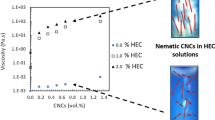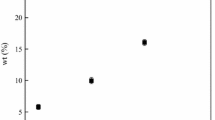Abstract
Cellulose acetate (CA) solutions have been shown to undergo phase-separation-induced gelation upon the addition of polar nonsolvents involving both hydrogen bonding and hydrophobic interactions. Using cellulose acetates with specific regiochemistry, only free hydroxyl groups at the C6 position of the anhydroglucopyranose unit, the viscoelastic behaviour and gel properties were evaluated. Steady-state and dynamic rheology indicate that both degree of acetylation (DA) and regiochemistry impact gel formation. Increasing nonsolvent content from 15 to 25 wt% substantially increased the elastic modulus (G′) of all ternary systems. At 15 wt% water G′ is significantly larger for the regioselective CA as compared to that of the random CA; consistent with the fact that the random CA is still in the solution phase while the regioselective CA are gels. At 20 wt% nonsolvent, the random CA and the regioselective CA of the same DA (~2.4) have approximately the same G′, while that of the regioselective CA with DA ~2.8 is significantly higher. Moreover, at the same DA, the random CA ternary system is less prone to rupture as it possess a longer linear viscoelastic region, i.e. drop in modulus occurs at higher stress than the corresponding regioselective CA ternary systems. However, at the same nonsolvent content the critical stress of the regioselective CA with DA ~2.8 is comparable to that of the random CA; suggesting the DA and not specifically regiochemistry affects gel modulus, but regiochemistry does influence stress behaviour.










Similar content being viewed by others
References
Appaw C, Gilbert RD, Khan SA, Kadla JF (2007) Viscoelastic behavior of cellulose acetate in a mixed solvent system. Biomacromolecules 8(5):1541–1547
Appaw C, Gilbert RD, Khan SA, Kadla JF (2010) Phase separation and heat-induced gelation characteristics of cellulose acetate in a mixed solvent system. Cellulose 17(3):533–538
Bansil R, Liao GD (1997) Kinetics of spinodal decomposition in homopolymer solutions and gels. Trends Polym Sci 5(5):146–154
Bochek AM, Kalyuzhnaya LM (2002) Interaction of water with cellulose and cellulose acetates as influenced by the hydrogen bond system and hydrophilic–hydrophobic balance of the macromolecules. Russ J Appl Chem 75(6):989–993
Butler MF, Heppenstall-Butler M (2003) Phase separation in gelatin/dextran and gelatin/maltodextrin mixtures. Food Hydrocolloid 17:815–830
Camacho Gómez JA, Erler UW, Klemm D (1996) 4-methoxy substituted trityl groups in 6-O protection of cellulose: homogeneous synthesis, characterization, detritylation. Macromol Chem Phys 197(3):953–964
Clasen C, Kulicke W-M (2001) Determination of viscoelastic and rheo-optical material functions of water-soluble cellulose derivatives. Prog Polym Sci 26(9):1839–1919
Edgar KJ, Buchanan CM, Debenham JS, Rundquist PA, Seiler BD, Shelton MC, Tindall D (2001) Advances in cellulose ester performance and application. Prog Polym Sci 26(9):1605–1688
Garside P, Wyeth P (2003) Identification of cellulosic fibres by FTIR spectroscopy: thread and single fibre analysis by attenuated total reflectance. Stud Conserv 48(4):269–275
Goodlett VW, Dougherty JT, Patton HW (1971) Characterization of cellulose acetates by nuclear magnetic resonance. J Polym Sci Pol Chem 9(1):155–161
Iwata T, Azuma J-I, Okamura K, Muramoto M, Chun B (1992) Preparation and n.m.r. assignments of cellulose mixed esters regioselectively substituted by acetyl and propanoyl groups. 224:283
Jaber BL, Cendoroglo M, Balakrishnan VS, Perianayagam MC, Karsou SA, Ruthazer R, King AJ, Pereira BJG (2000) Impact of dialyzer membrane selection on cellular responses in acute renal failure: a crossover study. Kidney Int 57(5):2107–2116
Kadla JF, Hsieh C-W (2012) Effect of processing conditions on gel formation in ternary cellulose acetate systems. Cellulose 19(1):69–79
Kadla JF, Korehei R (2010) Effect of hydrophilic and hydrophobic interactions on the rheological behavior and microstructure of a ternary cellulose acetate system. Biomacromolecules 11(4):1074–1081
Kadla JF, Korehei R (2011) Tuning the morphology of cellulose acetate gels by manipulating the mechanism of phase separation. Biomacromolecules 12(1):43–49
Kamide K, Saito M (1984) Effect of total degree of substitution on molecular parameters of cellulose acetate. Eur Polym J 20(9):903–914
Kawanishi H, Tsunashima Y, Okada S, Horii F (1998) Change in chain stiffness in viscometric and ultracentrifugal fields: cellulose diacetate in N,N-dimethylacetamide dilute solution. J Chem Phys 108(14):6014–6025
Kesting RE, Barsh MK, Vincent AL (1965) Semipermeable membranes of cellulose acetate for desalination in process of reverse osmosis. 2. Parameters affecting membrane gel structure. J Appl Polym Sci 9(5):1873–1893
Khalil SAH (1973) Phase separation of cellulose derivatives—effects of polymer viscosity and dielectric-constant of nonsolvent. J Pharm Sci 62(11):1883–1884
Kiykim AA, Horoz M, Ozcan T, Yildiz I, Sari S, Genctoy G (2010) Pulmonary hypertension in hemodialysis patients without arteriovenous fistula: the effect of dialyzer composition. Ren Fail 32(10):1148–1152
Krassig HH (1993) Cellulose; Structure, accessability and reactivity. Gordon and Breach, Yverdon
Liu JT, Chan SY, Ho PC (2002) Polymer-coated microparticles for the sustained release of nitrofurantoin. J Pharm Pharmacol 54(9):1205–1212
Pilon R, Kunst B, Souriraj S (1971) Studies on development of improved reverse osmosis membranes from cellulose acetate-acetone-formamide casting solutions. J Appl Polym Sci 15(6):1317–1334
Pintaric B, Rogosic M, Jasna Mencer H (2000) Dilute solution properties of cellulose diacetate in mixed solvents. J Mol Liq 85(3):331–350
Puleo AC, Paul DR, Kelley SS (1989) The effect of degree of acetylation on gas sorption and transport behavior in cellulose acetate. J Membrane Sci 47(3):301–332
Rocco RM (2005) Joachim Kohn (1912–1987) and the origin of cellulose acetate electrophoresis. Clin Chem 51(10):1896–1901
Rustemeyer P (2004) History of CA and evolution of the markets. Macromol Symp 208:1–6
Shih WH, Shih WY, Kim SI, Liu J, Aksay IA (1990) Scaling behavior of the elastic properties of colloidal gels. Phys Rev A 42(8):4772–4779
Skorayakov I, Komar V (1994) Determination of the content of bound acetic acid in cellulose acetates by the method of IR spectroscopy. J Appl Spectrosc 61(3):558–563
Suwantong O, Ruktanonchai U, Supaphol P (2008) Electrospun cellulose acetate fiber mats containing asiaticoside or Centella asiatica crude extract and the release characteristics of asiaticoside. Polymer 49(19):4239–4247
Tezuka Y, Tsuchiya Y (1995) Determination of substituent distribution in cellulose acetate by means of a 13C NMR study on its propanoated derivative. Carbohyd Res 273(1):83–91
Tsunashima Y, Hattori K (2000) Substituent distribution in cellulose acetates: its control and the effect on structure formation in solution. J Colloid Interf Sci 228(2):279–286
Tsunashima Y, Hattori K, Kawanishi H, Horii F (2001) Regioselectively substituted 6-O- and 2,3-di-O-acetyl-6-O-triphenylmethylcellulose: its chain dynamics and hydrophobic association in polar solvents. Biomacromolecules 2(3):991–1000
Tsunashima Y, Kawanishi H, Horii F (2002) Reorganization of dynamic self-assemblies of cellulose diacetate in solution: dynamical critical-like fluctuations in the lower critical solution temperature system. Biomacromolecules 3(6):1276–1285
Winter HH, Mours M (1997) Rheology of polymers near liquid-solid transitions. Neutron Spin Echo Spectros Viscoelast Rheol 134:165–234
Acknowledgments
We greatly acknowledge the Natural Sciences and Engineering Research Council of Canada (STPGP 336421) for financial support of this research.
Author information
Authors and Affiliations
Corresponding author
Rights and permissions
About this article
Cite this article
Hsieh, CW.C., Kadla, J.F. Effect of regiochemistry on the viscoelastic properties of cellulose acetate gels. Cellulose 19, 1567–1581 (2012). https://doi.org/10.1007/s10570-012-9750-0
Received:
Accepted:
Published:
Issue Date:
DOI: https://doi.org/10.1007/s10570-012-9750-0




